 most of the athletic staff, and more than two dozen boosters, crashed into a
wooded hill just short of the Tri-State
Airport near Huntington, West Virginia. All 75 people on
board died instantly.
most of the athletic staff, and more than two dozen boosters, crashed into a
wooded hill just short of the Tri-State
Airport near Huntington, West Virginia. All 75 people on
board died instantly.DC-9-30 Passenger Jet
Building Southern Airways N97S
(UNDER CONSTRUCTION)
At 7:35 p.m. on November 14, 1970, a
chartered DC-9 passenger jet carrying the Marshall University football team, most of the athletic staff, and more than two dozen boosters, crashed into a
wooded hill just short of the Tri-State
Airport near Huntington, West Virginia. All 75 people on
board died instantly.
most of the athletic staff, and more than two dozen boosters, crashed into a
wooded hill just short of the Tri-State
Airport near Huntington, West Virginia. All 75 people on
board died instantly.
It was, and remains, the worst sports-related airplane disaster in US history. In a single instant, the university's football team was almost completely wiped out. But there was more, much more. When Southern Airways charter flight 932 crashed in light rain and fog on that winter night, 70 children in Huntington lost at least one parent; 18 became instant orphans. The city lost four physicians, a city councilman and a newly-elected state representative. Huntington went into a state of collective shock and grief that lasted for many months; to this day, it is known around town simply as 'The Crash.' Every November 14th, at the same hour as the tragedy, Marshall University holds a special service at the memorial fountain in the center of campus which is dedicated to the victims.
The Crash might have remained
Huntington's
private tragedy, and largely was until 2005, when Warner
Brothers
announced it was making a movie based on The Crash, its aftermath and
the rebirth of Marshall's football program
against almost insurmountable odds.
We
Are Marshall evoked strong feelings in Huntington, even more than
three decades after the event. Many thought that anything Hollywood did would
trivialize the painful and personal losses so many
had
experienced. People who had never publicly shared their feelings and emotions about this
traumatic event now had to face having their story shared with the entire world. The movie's director and actors had to work hard to win the community's
trust.
on The Crash, its aftermath and
the rebirth of Marshall's football program
against almost insurmountable odds.
We
Are Marshall evoked strong feelings in Huntington, even more than
three decades after the event. Many thought that anything Hollywood did would
trivialize the painful and personal losses so many
had
experienced. People who had never publicly shared their feelings and emotions about this
traumatic event now had to face having their story shared with the entire world. The movie's director and actors had to work hard to win the community's
trust.
To its credit, and in my personal opinion, Warner Brothers did a good job. We Are Marshall premiered on Dec. 12, 2006, in Huntington at the Keith-Albee Theater (which had a minor role in The Crash and the movie) and has gone on to moderately successful aftermarket sales and a sort of lasting fame for both Marshall and Huntington.
As a modeler, I focused in on the airplane
involved, the DC-9. I wanted to create a replica of N97S as my own personal
homage to the team, the town, and what both have become since The Crash.
Unfortunately, the only decent plastic DC-9 model in the correct version, the DC-9-30,
is an old, long out of production Airfix kit. Despite misgivings, I had to
resort to Ebay for that as well as the Southern Airways decals to go
with it. I wanted my model to be right.
Southern Airways decals to go
with it. I wanted my model to be right.
The makers of We Are Marshall tried, and they did pretty good. They managed to find a DC-9-15 in Georgia (where most of the filming was done) and painted one side of it in Southern Airways markings circa 1970. Although that DC-9 is some 15 feet shorter than the -30 version, no one but a hard core airliner fanatic was going to notice that detail. What is noticeable (to me at least) is the movie airplane's paint scheme - the blue is too light, almost a medium blue, and the gold trim is more of a bright yellow. There were a few other little things:
The plane's registration number, N97S, should be on the aft fuselage in white, centered on the dark blue 'cheat line.' The filmmakers put it in black on the nose wheel door;
What does belong on the nose wheel door is Southern's fleet number for that aircraft, 932, which should also have been in black in small numbers on the tail;
The large blue Southern legend on the fuselage should be italicized, likewise the white Southern legend on the engine nacelle;
The 'aristocratic S' on the tail is at a funny angle; it should be much more horizontal to the aircraft's fuselage;
'Southern DC-9' should have been in white lettering in two rows on the blue cheat line, just to the right of the main passenger door;
The antiglare panel in front of the cockpit windows should be black, not blue;
The bottom half of the engine nacelles, underneath the gold line, should be natural metal, not blue;
Likewise, the fuselage below the line of the wing root from nose to tail should be natural metal, not white;
The yellow nose tip ... is a tough call. Starting in 1970, a lot of Southern Airway's planes had a yellow smiley face with 'Southern Airways' and 'Have A Nice Day' around it added to the nose, yellow replacing the normal black paint. The filmmakers, perhaps sensitive to the tragedy that ensued, left off the black smiley face and Have A Nice Day lettering while keeping the yellow nose. I was unable to determine if N97S had a smiley face, and decided to leave it off in deference to The Crash.
Minor details, but enough for me to go all out in accurizing my attempt. This was my first foray into 1/144 scale, a common one for airliner models. It took some getting used to, as did the facts that I was going to have to create absolutely smooth and blemish-free finishes, and cope with lots windows - 74 tiny little ones (77 counting the cockpit and access doors).
Unpleasant Discoveries
Airliners aren't that hard to put together - there are a lot fewer parts than with a warplane, for instance. Painting and decaling them, however, can be, well ... pureunmitigatedhell.
First, trying to get a smooth, flawless, gloss white finish is something I've never had to do before. Now I know why I don't build model cars. I ended up getting two DC-9 kits on Ebay, wanting to use the first one as a test bed/learning tool. I filled in the windows on one side with plastic strip and putty and then spent days trying to get the fuselage mostly smooth. One of the kits had no clear plastic parts (typical Airfix), so that meant filling in and sanding the windshield to shape as well (which didn't turn out that great).
Second, applying longggggggggg decals like the cheat line that goes along the windows, or the window decals themselves, or the airline name, is hard. As in very hard. As in more pureunmitigatedhell and something I was not able to get even close to right on my first attempt. Glad I bought two of these things. Third, the one set of decals I bought on Ebay had yellowed significantly, something the odd-colored backing paper hid very well until I tried to slide the first decal onto that smooth, glossy white fuselage. Then it showed up just fine! But I was in too deep by that time to stop.
So here it is, my first attempt at an airliner, and the We Are Marshall airplane:
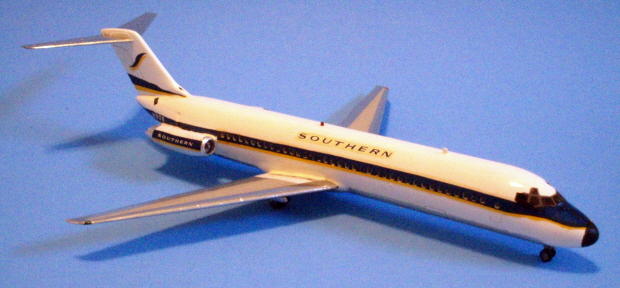 |
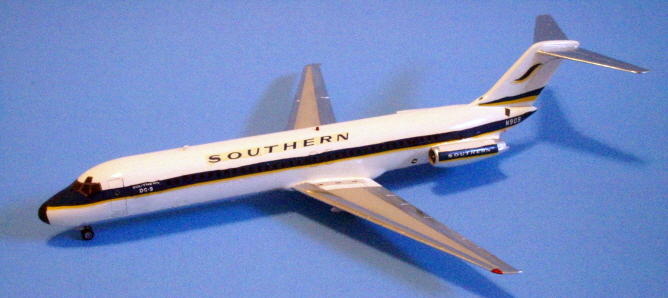 |
|
| Right quarter view of the We Are Marshall DC-9. You never appreciate how long and skinny these airliner models are until you start gluing one together.
|
Left front quarter view of the model, showing my numerous
attempts to patch together that really long window cheat line decal after
having it self destruct when I tried to do it in one long piece.
|
|
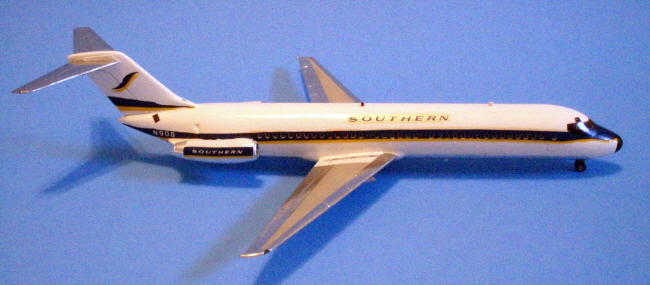 |
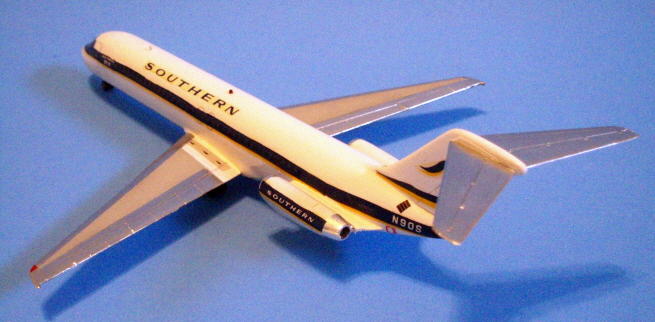 |
|
| Right side view. Another thing I had a lot of trouble with was using Bare Metal Foil for the leading and trailing edges of the wings, the horizontal stabilizers, most of the belly and around the front and rear of the engine nacelles. It proved almost impossible to piece bits together without visible overlaps, but I did get better with practice.
|
Left rear quarter view, showing off the chrome Bare Metal Foil used on the stabilizers and leading and trailing edges. I didn't realize until the model was almost complete that the gray anti-corrosion panels on each wing weren't identical on each side ... |
|
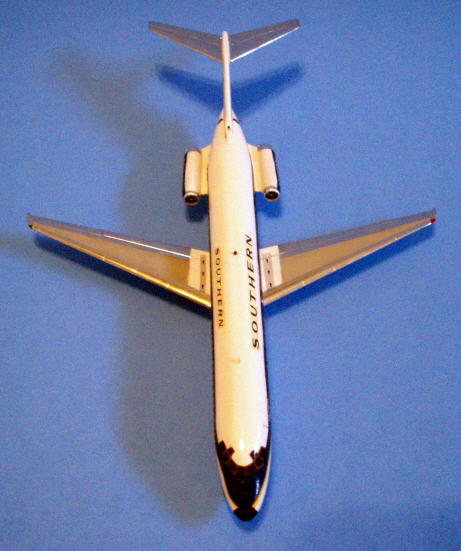 |
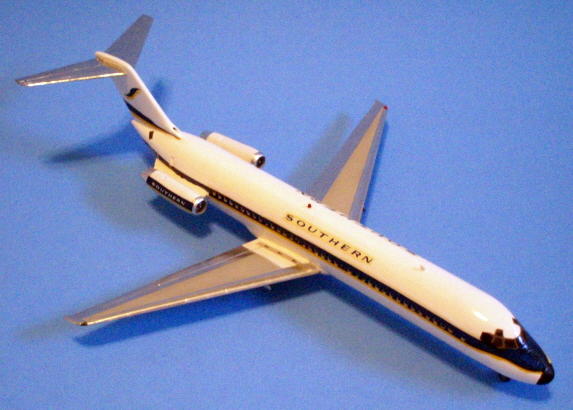 |
|
| Overhead view of the We Are Marshall DC-9 from the nose. You may notice that the Southern logo on each side of the fuselage is different. The reason for that was that one of the large decals ripped into such small pieces that I wasn't able to piece it together, so I had to use one of the smaller Southern names for the right side. |
Another right front quarter view of the model. At least it looks like a DC-9 ... from a distance!
|
So there you have it ... for now. I'm going to have to take a breather from this civilian stuff for awhile and get back to my wartime ships, where a glossy white finish is the absolute last thing you see and decals, if any, are few and very tiny.
But I will be back with Part 2! Sometime.
Return to the Modeling Index Page
This page was last updated Dec. 26, 2008.